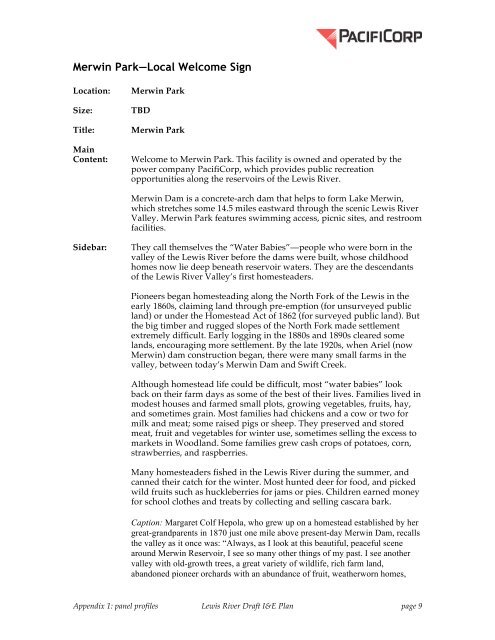The Lewis River Hydroelectric Projects - PacifiCorp
The Lewis River Hydroelectric Projects - PacifiCorp
The Lewis River Hydroelectric Projects - PacifiCorp
Create successful ePaper yourself
Turn your PDF publications into a flip-book with our unique Google optimized e-Paper software.
Merwin Park—Local Welcome Sign<br />
Location:<br />
Size:<br />
Title:<br />
Main<br />
Content:<br />
Merwin Park<br />
TBD<br />
Merwin Park<br />
Welcome to Merwin Park. This facility is owned and operated by the<br />
power company <strong>PacifiCorp</strong>, which provides public recreation<br />
opportunities along the reservoirs of the <strong>Lewis</strong> <strong>River</strong>.<br />
Merwin Dam is a concrete-arch dam that helps to form Lake Merwin,<br />
which stretches some 14.5 miles eastward through the scenic <strong>Lewis</strong> <strong>River</strong><br />
Valley. Merwin Park features swimming access, picnic sites, and restroom<br />
facilities.<br />
Sidebar:<br />
<strong>The</strong>y call themselves the “Water Babies”—people who were born in the<br />
valley of the <strong>Lewis</strong> <strong>River</strong> before the dams were built, whose childhood<br />
homes now lie deep beneath reservoir waters. <strong>The</strong>y are the descendants<br />
of the <strong>Lewis</strong> <strong>River</strong> Valley’s first homesteaders.<br />
Pioneers began homesteading along the North Fork of the <strong>Lewis</strong> in the<br />
early 1860s, claiming land through pre-emption (for unsurveyed public<br />
land) or under the Homestead Act of 1862 (for surveyed public land). But<br />
the big timber and rugged slopes of the North Fork made settlement<br />
extremely difficult. Early logging in the 1880s and 1890s cleared some<br />
lands, encouraging more settlement. By the late 1920s, when Ariel (now<br />
Merwin) dam construction began, there were many small farms in the<br />
valley, between today’s Merwin Dam and Swift Creek.<br />
Although homestead life could be difficult, most “water babies” look<br />
back on their farm days as some of the best of their lives. Families lived in<br />
modest houses and farmed small plots, growing vegetables, fruits, hay,<br />
and sometimes grain. Most families had chickens and a cow or two for<br />
milk and meat; some raised pigs or sheep. <strong>The</strong>y preserved and stored<br />
meat, fruit and vegetables for winter use, sometimes selling the excess to<br />
markets in Woodland. Some families grew cash crops of potatoes, corn,<br />
strawberries, and raspberries.<br />
Many homesteaders fished in the <strong>Lewis</strong> <strong>River</strong> during the summer, and<br />
canned their catch for the winter. Most hunted deer for food, and picked<br />
wild fruits such as huckleberries for jams or pies. Children earned money<br />
for school clothes and treats by collecting and selling cascara bark.<br />
Caption: Margaret Colf Hepola, who grew up on a homestead established by her<br />
great-grandparents in 1870 just one mile above present-day Merwin Dam, recalls<br />
the valley as it once was: “Always, as I look at this beautiful, peaceful scene<br />
around Merwin Reservoir, I see so many other things of my past. I see another<br />
valley with old-growth trees, a great variety of wildlife, rich farm land,<br />
abandoned pioneer orchards with an abundance of fruit, weatherworn homes,<br />
Appendix 1: panel profiles <strong>Lewis</strong> <strong>River</strong> Draft I&E Plan page 9
















